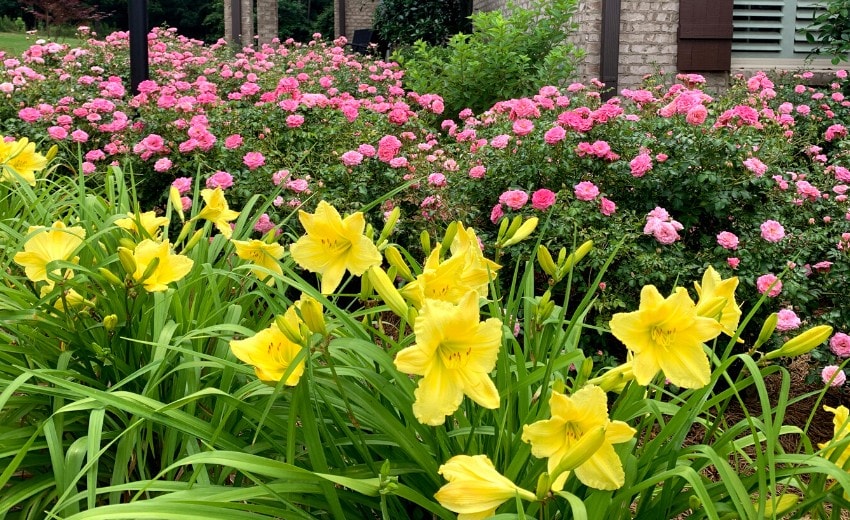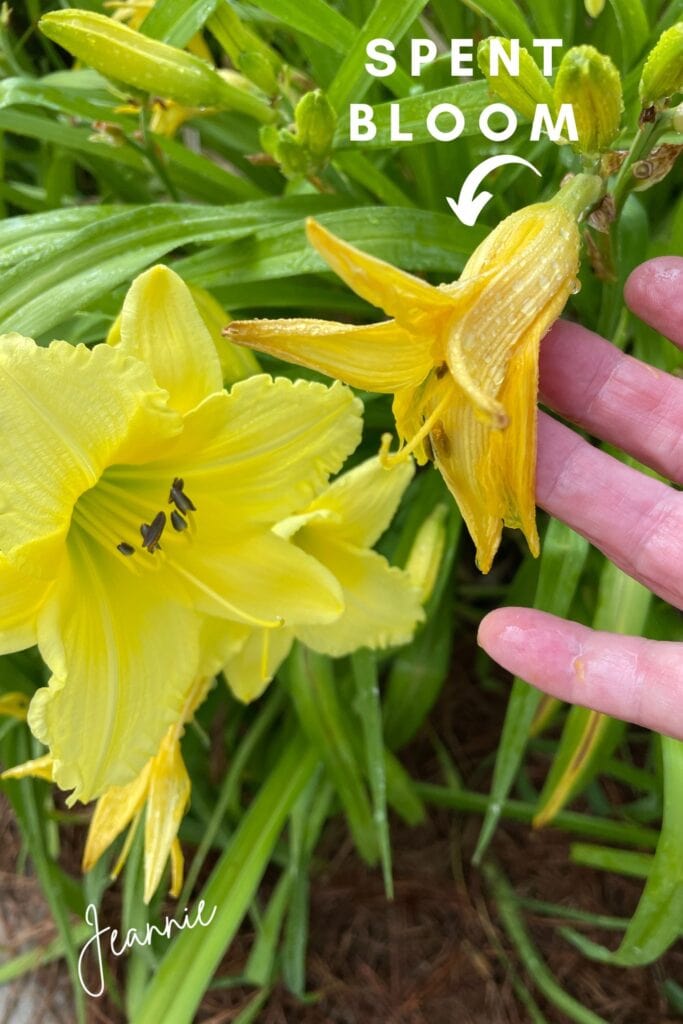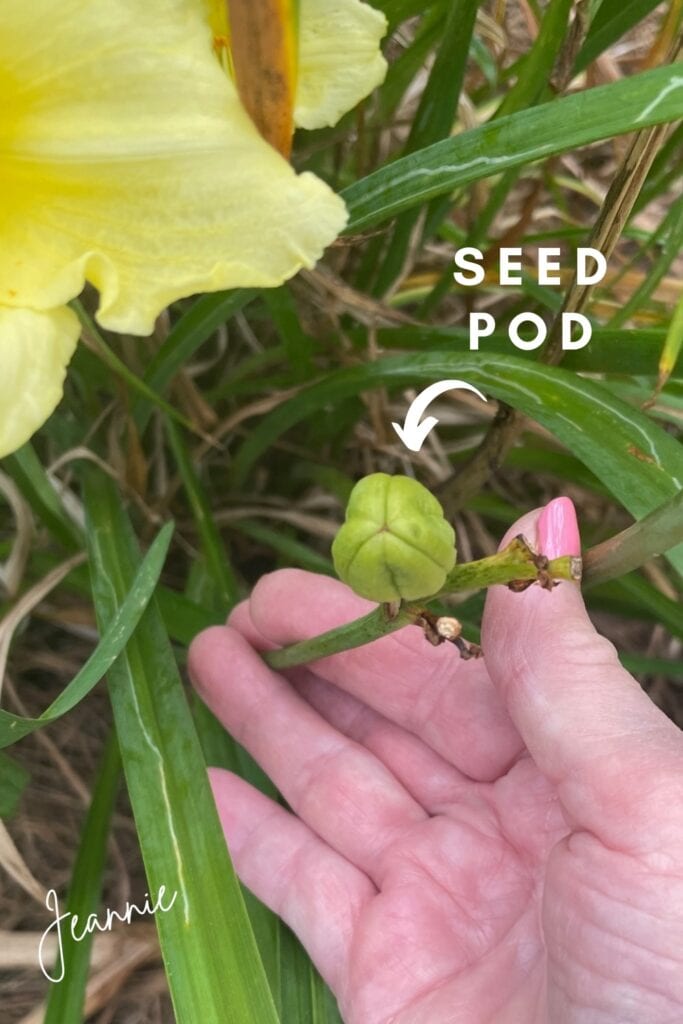Deadhead Daylilies Yes or No?
The Question – Does Deadheading Daylilies Stimulate New Blooms?
Well, I thought it was going to be a fairly simple question to answer. Not! I’m no expert gardener and can hardly keep a plant alive, but I thought deadheading lilies contributed to more blooms.
So, I figured I just needed to research this question to make an accurate post about it. Not so simple.
Deadheading Spent Blooms
There seems to be no question that deadheading spent daylily blooms makes a difference. It makes the plants look better and removing spent blooms (and stems once all the buds have bloomed) allows for the plant to have more energy for better health. For lack of a better description.
Also spent blooms are soft and mushy and can fall down over a bud and hinder its blossoming. So, no doubt about it, deadhead those lilies!
It’s quite a job though if you have many plants. It’s not hard, you just have to pinch off the spent blooms without disturbing the remaining buds. And you have to bend over!
My husband fussed at me for pinching off the spent blooms and tossing them in the yard. So I stopped doing that and started putting them in a bag. My goodness…..I was getting 2-3 pounds of spent blooms every day! It’s backbreaking work, but well worth it)))
Research
I tried to do some research (internet) to find out if deadheading encouraged new blooms or not. For many flowers, deadheading does encourage new growth. It’s not so straightforward with daylilies.
Some articles said it did….others said the number of buds is set and deadheading does not create new blooms.
One article said when all the blooms were spent from a stem, remove that stem deep at the base of the plant to encourage more blooms. That sort of made sense and I’m watching some of my plants to see if it puts out new stems with more buds. We will see.
Experts
I decided to reach out to the experts, The American Daylily Society. Not sure that I would get an answer but I just wanted to know, does deadheading stimulate more blooms? It seemed like a simple enough question. But I guess I was wrong.
The person at The American Daylily Society very promptly responded to my request which was extremely nice. Here’s the answer I received:
“It is helpful to deadhead daylilies. If you want to keep the daylily true to form and itself, deadheading will remove any seed pods that may have been set by insects, or butterflies. If not removed the seed pods produce a seed that is a different daylily from the parent. So, you will have a different daylily.”
Not the answer I was looking for but maybe it’s not a black-and-white issue. I was glad to know about the importance of removing the seed pods. Now I can understand why one of my replacement lilies has changed colors.
All I know about the ones in my yard is that they are Stella d’oro and have a lemon-yellow color. That odd plant that I replaced, started out yellow and now it’s that yucky orange.
I reached out to my contact at The American Daylily Society, and that person has forwarded my question to the Scientific Studies Chairman. If I receive a response I’ll update this post.
June 15, 2022 Update
Here’s what I received from the Scientific Studies Committee:
Although there has been no actual scientific research on this topic that we’re aware of, the consensus from experience is that deadheading does not result in more flowers and nor does the removal of finished scapes. Research has, however, shown that daylilies actually retrieve nutrients from the dying flowers (and probably green scapes) so it’s even possible that removal too soon may have a negative effect.
June 11, 2022 Update
I heard from the Chair of the American Daylily Society Scientific Studies Committee. It seems the question wasn’t a simple one and it has now been referred to the committee. So, we’ll just have to wait and see. What I thought would be a simple yes or no….just isn’t that simple!
I really appreciate the people taking the time and effort to find an answer to my question. It was heartwarming to know that the society would be so helpful)))
Until then…..I’ll just keep on deadheading those spent blooms and enjoy my daylilies. But now I need to start removing stems that have gone to seed pods….more work to do!
Final Note
Oh! I did find out where the name “daylily” comes from……it’s because the blooms only last a day))) Guess I should have figured that one out))))
11/3/22 Update
Once my daylilies had all bloomed and leaves were turning brown, we cut them down. I was worried at first that we had destroyed them forever. But after a few weeks, they came back with beautiful foliage. A rare bloom here and there, but the foliage continues to look pretty.

More from My Blog
beautiful blooms
Summer Crush Hydrangeas
Summer Crush hydrangeas…..we’re trying again! Last year (2021) we set out 15 FIFTEEN Summer Crush hydrangeas……one lived. Now I’m not saying it was the fault of the plants. We’ve decided it was the location we planted them in and it was just simply too hot for them and they didn’t get enough shade.
fresh blackberries
Blackberry Pickin’ Time!
June is blackberry pickin’ time in the South! Ever since June 1st, I’ve been craving blackberries. I had a blackberry cobbler in mind actually. Blackberry cobbler was the first thing my mother taught me how to make.




I loved your article.
I am no gardener, but I planted a daylily at first it bloomed and bloomed. I cut back the stalks and now the foliage doesn’t look that good. Should I cut it all the way back and see what happens?
Thank you.
Thank you for visiting my blog)) we cut ours back to the ground after the leaves turn brown and then they always start coming back green in a few weeks. Especially in the spring. Mine look good right now but haven’t started putting out bloom stems yet. We live in MS if that makes a diff